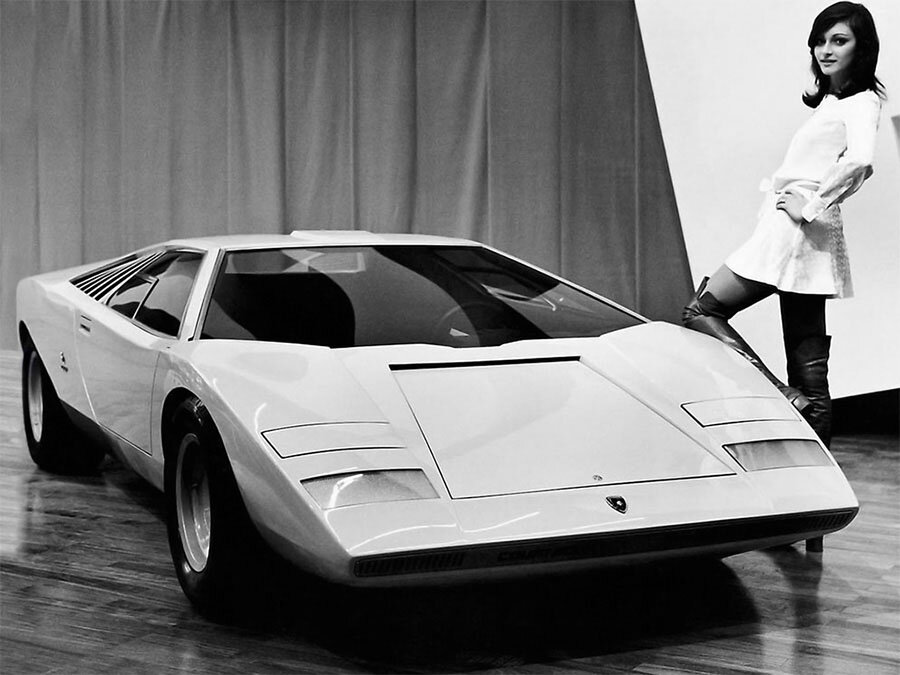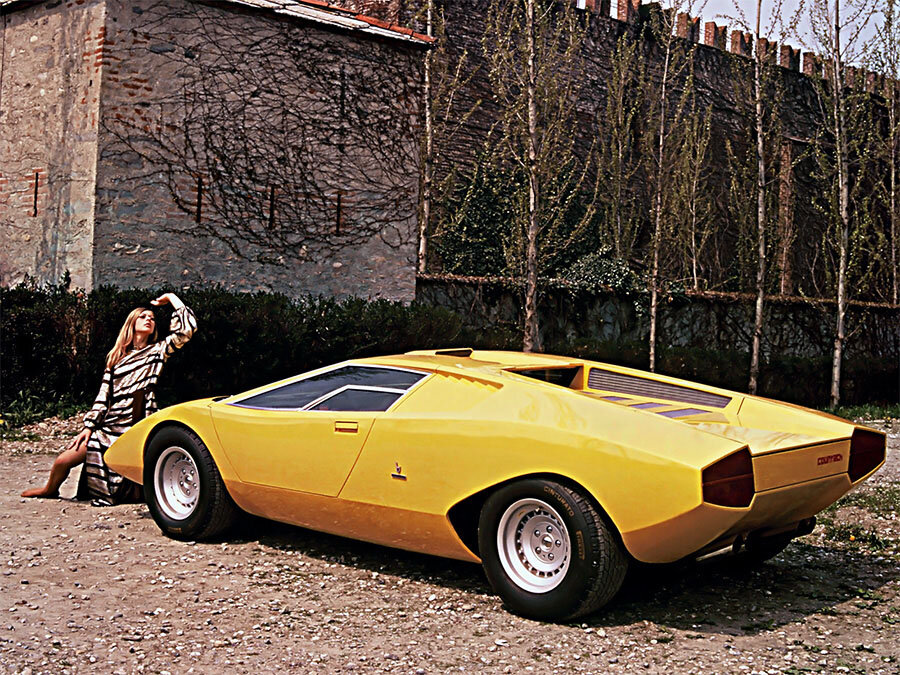Guide: Nothing Else Matters - a Historical & Technical Appraisal of the Lamborghini Countach LP500
/BACKGROUND
Following Giorgetto Giugiaro’s departure to establish Ital Design in 1968, Marcello Gandini took over as head stylist at Bertone. The two men had collaborated on Lamborghini’s Miura, but freed from Giugiaro’s oversight, Gandini single-handedly ushered in a new era of highly influential wedge design.
The first pure Gandini creation to arrive from the Bertone studio was the Alfa Romeo Tipo 33 Stradale-based Carabo. Unveiled at the Paris Motor Show in October 1968, with its up-hinged scissor doors and radical profile, the metallic green and orange projectile caused a sensation.
Twelve months later, Bertone unveiled the diminutive Autobianchi A112 Runabout at the Turin Motor Show.
In 1970, this was followed by arguably the most extreme interpretation of wedge design yet - the Lancia Stratos Zero.
Displayed at the Turin Motor Show in October 1970, the Zero (like the Carabo and Runabout) was fully operational if somewhat impractical for day-to-day use. Nevertheless, Bertone had proved that, with a little refinement, the wedge could become a useable reality. Brave manufacturers were all that was needed.
Three firms stepped up to the plate. Fiat commissioned the X1/9 and Lancia ordered the Stratos, but by far the most exciting and technically challenging engagement came from Lamborghini.
The young company from Sant’Agata had already worked with Bertone to produce the Miura, Marzal and Espada. These three cars had made a massive impact and Lamborghini were quick to sign up for a Bertone-designed mid V12-engined flagship to replace the Miura.
The resultant Countach LP500 was unveiled at the Geneva Motor Show in March 1971. Its angular form was a complete contrast to the Miura’s soft curves.
Orders for the new car came flooding in. However, at this stage the Countach was far from production-ready. It would need considerable development before deliveries could begin.
ENGINE / TRANSMISSION
Codenamed Project 112, the LP500 moniker was a reference to the car’s engine location and size. LP stood for Longitudinale Posteriore (longitudinal rear). The 500 denoted a five-litre engine capacity.
A longitudinal engine layout was adopted instead of the Miura’s transverse arrangement to improve handling, stability and access.
Prior to the new car’s arrival, the 60° dual overhead camshaft V12 that Giotto Bizzarrini designed for Lamborghini had only been used in 3.5 and four-litre applications.
In four-litre trim, a displacement of 3929cc was achieved thanks to a bore and stroke of 82mm and 62mm respectively. For the Countach LP500, bore and stroke were taken out to 85mm and 73mm resulting in a cubic capacity of 4971cc.
Not only was this prototype Tipo L500 engine ambitiously enlarged, it also contained a considerable quantity of magnesium, as did the gearbox and differential.
Although dry-sump lubrication would be adopted for a handful of late Miuras, the Tipo L500 motor and all subsequent Countach engines used a conventional wet-sump arrangement.
Compression was reduced to 10.5:1 as opposed to the 10.7:1 of contemporary Miuras.
Six enormous Weber 45 DCOE sidedraught carburettors were installed and water radiators were longitudinally mounted alongside the engine.
Peak output was 440bhp at 7000rpm and 367lb-ft at 5000rpm.
By comparison, the latest Miura SV (also launched at Geneva in 1971) produced 385bhp at 7850rpm and 285lb-ft at 5750rpm.
Despite the five-litre engine’s credentials being widely publicised at the time, the engine was only briefly fitted into the prototype Countach. When it blew during testing later in 1971, Lamborghini fitted a conventional four-litre unit.
With neither the time or money to continue working on the five-litre motor, the project was mothballed until the deep pockets of Walter Wolf arrived a few years later.
To avoid placing the mass of the transmission at the rear, the five-speed gearbox was mounted in the middle of the car between the two seats. Lamborghini used their own five-speed gearbox and differential, a Porsche synchromesh and Fichtel & Sachs single dry-plate clutch.
CHASSIS
The chassis was a semi monocoque built by Marchesi with square steel tubes and welded sheet panels for additional stiffness. At 107kg, it was around 30% heavier than the Miura chassis despite having a 50mm shorter wheelbase (2450mm).
Production Countachs would come with much lighter pure spaceframes, but a heavy-duty chassis was commissioned for the prototype as it was expected to lead a hard life and rack up many thousands of test kilometres.
Suspension was fully independent all round. Double wishbones were fitted at the front with upper lateral links, reversed lower wishbones and upper and lower trailing arms at the back. Coil springs and telescopic Koni dampers were installed at each corner (two per side at the rear). Anti-roll bars were fitted at either end.
The un-ventilated disc brakes were supplied by Girling in England. They ran off a separate hydraulic circuit for each axle.
14-inch diameter cast magnesium wheels were designed by Bertone and manufactured by Campagnolo. The rims measured 7-inches wide at the front, 9-inches wide at the back and came shod with specially developed Pirelli Cinturato tyres.
Fuel tanks with an overall capacity of 140-litres were located at the rear of each sill.
BODYWORK
Despite a mouth-watering technical specification, it was undoubtedly Bertone’s bodywork that caused the Countach to become an overnight sensation. Perhaps the most extreme road car design of the decade, its angular form made the soon-to-be-replaced Miura look decidedly old hat.
Access to the cockpit was via hydro-pneumatic doors that rose scissor-like parallel to the body. When opened, they further accentuated the car’s other-worldly appearance.
Trapezoidal shapes appeared throughout the body to include the windscreen, side windows, door openings, tail lights, front lid and engine cover.
The overall profile was unencumbered by aerodynamic aids or safety devices. Bertone even ditched conventional rear view mirrors in favour of a tunnel-mounted periscope in the roof.
Retractable headlights were mounted above supplementary lights located under clear plastic covers (a layout inspired by the 1969 Mercedes-Benz C111).
Although the Countach prototype was fitted with steel panels, production cars had bodies fashioned from aluminium.
INTERIOR
The interior was no less impressive.
Behind the single spoke steering wheel was a digital dash in the centre of which were a series of warning lights.
To the left of the dash was a schematic view of the car that displayed the status of various systems thanks to an on-board diagnostics computer. Lights, brakes, fluid levels and temperatures were all continually monitored and the driver immediately notified of any problems.
Once over the wide sills, occupants were provided with single piece bucket seats.
Owing to the door design, the small sub-windows could only be lowered a couple of inches.
WEIGHT / PERFORMANCE
The Countach LP500 weighed in at 1320kg.
It had a top speed of circa 190mph and 0-62mph time of under five seconds.
LAUNCH
The Countach LP500 was presented on the Bertone stand at Geneva in 1971. On the Lamborghini stand was the new Miura SV.
To make the show on time, chief test driver and development engineer, Bob Wallace, had driven the Countach from Sant’Agata to Switzerland the previous night.
DEVELOPMENT
Over the next two years, Wallace routinely thrashed the yellow prototype around Italy ironing out the myriad problems such a state-of-the-art design inevitably suffered.
Cooling was the biggest concern. To improve airflow into the engine bay, NACA ducts were added down each flank and intake boxes were tacked on to each sail panel.
The digital dash was also quickly discarded.
With serious question marks over the five-litre engine’s longevity (and no cash to develop it further), Lamborghini opted to fit a four-litre unit into the subsequent production model.
In March 1974 and with production about ready to get underway, the by now tired and tatty Countach prototype was taken to the MIRA headquarters in England where it was crash tested to gain type approval.
Text copyright: Supercar Nostalgia
Photo copyright: Lamborghini - https://www.lamborghini.com





































